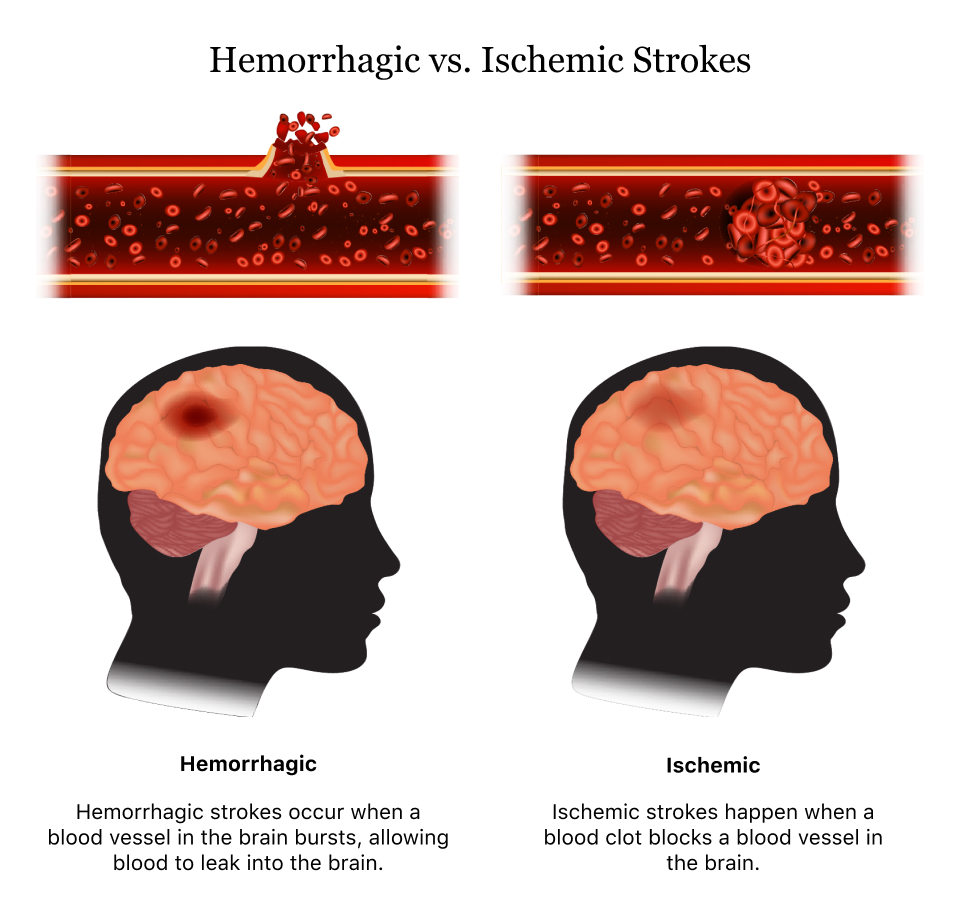Which of the Following Is Accurate Regarding a Hemorrhagic Stroke
There are two other types of weakened blood vessels that also cause hemorrhagic stroke. Which of the following is accurate regarding a hemorrhagic stroke.

Stroke Symptoms Causes And Stroke Prevention
Which of the following is accurate regarding a hemorrhagic stroke.

. Epidemiologic studies indicate that only 8-18 of strokes are hemorrhagic. A It is caused by a large-artery thrombosis. You may also hear it called a brain haemorrhage or a brain bleed.
E Ischemic stroke will eventually produce a hemorrhagic stroke. Computed tomography CT or magnetic resonance imaging MRI with high sensitivity for intracerebral hemorrhage are essential in diagnosis. Through the years The American Hospital Associations AHA Coding Clinic for ICD-9-CM has tackled a variety of stroke-related.
It is caused by a large-artery thrombosis. About 13 percent of strokes are hemorrhagic. The incidence of stroke is higher in men than women.
Which of the following is TRUE regarding a hemorrhagic stroke. A hemorrhagic stroke occurs when a weakened blood vessel ruptures and spills blood into brain tissue. D Hemorrhagic strokes are associated with tumor compression of nerve tissue.
The two types o stroke are hemorrhagic and ischemic. The appearance of intracranial hematoma ICH on CT and MR imaging evolves over time and must be understood to facilitate accurate diagnosis. Which of the following is accurate regarding a hemorrhagic stroke.
The two types of hemorrhagic strokes are intracerebral within the brain hemorrhage or subarachnoid hemorrhage. The primary treatment for people with hemorrhagic stroke involves supportive care and optimiz. A Functional recovery usually plateaus at 6 months.
A Main presenting symptom is an exploding headache B Functional recovery usually plateaus at 6 months. It can result from excessive bleeding in the cerebSl arteries that prevents blood from flowing to brain cells. A Hemorrhagic strokes are associated with bleeding within the heart.
C Main presenting symptom is an exploding headache d Functional recovery usually plateaus at 6 months. Which of the following is accurate regarding a hemorrhagic stroke. In the UK around 15 of strokes are haemorrhagic due to a bleed and about 85 are ischaemic due to a blockage to the blood supply in the brain.
Following a hemorrhagic stroke a person may experience severe headaches for some time. Seizures vomiting and headache are symptoms that make a hemorrhagic stroke more likely. Signs of worsening levels of consciousness neck stiffness or diastolic blood pressure 110 mm Hg and xanthochromia in cerebrospinal fluid make a hemorrhagic stroke more likely.
Main presenting symptom is an exploding headache 3. Main presenting symptom is an exploding headache The nurse is caring for a client with aphasia. B One of the main presenting symptoms is numbness or weakness of the face.
The most common cause for the rupture is uncontrolled hypertension high blood pressure. Functional recovery usually plateaus at 6 months. Which of the following is accurate regarding a hemorrhagic stroke.
Hemorrhagic stroke accounts for approximately 15 of strokes. A hemorrhagic stroke is also called. C Main presenting symptom is an exploding headache d It is caused by a large-artery thrombosis.
A doctor will provide pain relief medication. The presence of a cervical bruit makes a hemorrhagic stroke less likely. A hemorrhagic stroke occurs when a weakened blood vessel ruptures.
It is especially important however when reporting conditions such as stroke which more often than not involves multiple symptoms diagnoses and complications. Aneurysms and arteriovenous malformations AVMs. The majority of strokes are ischemic.
The most common etiology of primary hemorrhagic stroke intracerebral hemorrhage is hypertension. One of the main presenting symptoms is numbness or weakness of the face. For the past 3 decades aspirin has been widely used for prevention of ischemic stroke and myocardial infarction.
Consuming caffeine and alcohol may make the headaches worse. Neuroimaging by CT or MR imaging is necessary for the identification of hemorrhagic stroke and provides information about its cause. The risk factors for stroke are the same as those for cardiovascular disease.
Although the evidence supporting the effectiveness of aspirin in prevention of vascular events is clear data regarding the risk of acute and recurrent intracerebral hemorrhage related to the use of this medication have been conflicting. Stroke is the 4th leading cause of death in the United States. Hemorrhagic strokes can be treated with anticoagulant medication.
These are strokes that are caused by a rupture in a blood vessel in the brain. It can result from the loss of blood flow to a region of the brain because of a buildup of. Two types of weakened blood vessels usually cause hemorrhagic stroke.
Which of the following is accurate regarding a hemorrhagic stroke. B Ischemic strokes are related to excessive vasodilation of the brain blood vessels. Clinical documentation plays a vital role in all coding.
Which of the following is accurate regarding a hemorrhagic stroke. The cause of ICH varies by location. A Functional recovery usually plateaus at 6 months.
At least two thirds of patients with primary intraparenchymal hemorrhage are reported to have. B One of the main presenting symptoms is numbness or weakness of the face. C One of the main presenting symptoms is numbness or weakness of the face.
C The risk of stroke increases with age. B One of the main presenting symptoms is numbness or weakness of the face. Hemorrhagic stroke is less common than ischemic stroke ie stroke caused by thrombosis or embolism.
If blood leaks from a blood vessel in or around the brain this is called a haemorrhagic stroke. Aneurysms and arteriovenous malformations AVMs.


No comments for "Which of the Following Is Accurate Regarding a Hemorrhagic Stroke"
Post a Comment